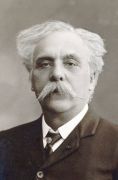
Gabriel Fauré
(1845–1924)

 |
Gabriel Fauré |
 |
Gabriel Fauré's parents lived in the South West of France close to the Pyrenees. His father was Head of a Teacher Training College near Foix an ancient town dominated by its castle. By the time he was 9 years old Fauré's exceptional musical talent had been recognised and he was sent to study in Paris at Ecole Neidermeyer a Conservatoire dedicated to the training of organists and choir masters. It was to this very particular musical education that Fauré owed his continuous employment as an organist, despite his loss of religious faith, culminating in his appointment to the Paris Madeleine church in 1896 where he completed his Requiem.
Fauré won many prizes while at the the Ecole Neiderneyer, including a first prize in composition for the Cantique de Jean Racine Op. 11, which remains popular with British audiences, the Cantique was placed 148 out of 500 in the Classic FM Hall of Fame in 2020. Faure left Neidemeyer as a Laureat in organ, piano, harmony and composition and a lifelong of his composition teacher Camille Saint-Saëns.
In 1870 Fauré as a patriot, fought with the French Army against the invading Prussians but, unlike many of his fellow writers, artists and musicians, he did not support the Paris Commune. Instead he left for a teaching post at the Niedemeyer which had relocated to Switzerland. When he returned to Paris Faure became a founding member of the Société Nationale de Musique, formed in February to promote new French music and help restore France's sense of pride in her national and cultural achievements. Other members included Bizet, Duparc, Franck, Ravel and Massenet. Fauré became secretary of the society in 1874. Many of his works, including for piano, were first presented at the society's concerts.
Fauré's earnings as an organist were steady but modest. He earned little from the songs, for which he is so famous. They were sold outright to his publisher so there were no royalties. His professional life was a struggle his music, with its unique voice, being regarded as too modern by the Paris Conservatoire. It was only in 1902 that he became its Director and was able to introduce reforms such as entry on merit.
In 1883 Faure married Marie Fremiet, the daughter of a well known French sculptor. They had two sons. In his late 40s, the married Fauré fell in love with Emma Bardac. The affair inspired a new burst of creativity. He wrote the Dolly Suite for piano for Bardac's daughter Hèlène, known as Dolly. Some suspect that she was his daughter. In the above image they are playing together. Faure's very complicated love life contributed to his personal and financial difficulties and bouts of depression. In an effort to cheer him up Faure's great friend Saints-Saëns introduced him to Wagner's music, of which he became a great fan.
Fauré spent years at the Madeleine writing and re-writing his Requiem which he finally completed in 1900. He said of this work “Everything I managed to entertain by way of religious illusion I put into my Requiem, which moreover is dominated from beginning to end by a very human feeling of faith in eternal rest”. The Requiem with its message of consolation is probably his best known and best loved composition. In 2020 it was 45 in Classic FM's Hall of Fame having risen 13 places with no other French composer above it.
Fauré was a lifelong heavy smoker and though he lived to be 79 he was not in good health in his last years. In 1920, at the age of 75, Fauré retired from the Conservatoire because of increasing deafness and frailty. In that year he received the Grand-Croix of the Légion d'honneur, an honour rare for a musician. The Musical Times described “a splendid celebration at the Sorbonne, in which the most illustrious French artists participated … It was a poignant spectacle, indeed: that of a man present at a concert of his own works and able to hear not a single note.” He died in 1924 having after a great struggle completed his string quartet. The quartet was premiered after his death.